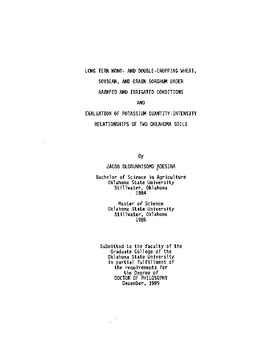| dc.description.abstract | Many growers continue to have interest in double-cropping hard red winter wheat {Triticum aestivum {L.} em Thell}, soybean {Glycine max L. Merr.}, and grain sorghum {Sorghum bicolor {L.} Moench} in the eastern part of Oklahoma. Fall, winter, and spring precipitation is usually sufficient in this part of the state to produce wheat. Removal of water from the soil profile by the wheat crop and erratic distribution of rainfall during the summer months, however, often results in soil moisture deficits during the reproductive growth stages of both doublecropped soybean and grain sorghum. An eight-year {1981-1988} field study was conducted at the. Oklahoma Vegetable Research Station, Bixby, Oklahoma, on a Wynona silt loam soil {Cumulic Haplaquoll} with 0-1% slope. The objective of the field investigation was to evaluate the long-term yields of mono- and double-cropped wheat, soybean, and grain sorghum. All wheat was produced under rainfed conditions while soybean and grain sorghum were produced under both conventional and no-till systems and under irrigated and rainfed conditions in eastern Oklahoma. Over the 8-yr study period, monocropped wheat yielded an average of 2970 compared with an average of 2405 kg ha^-1 for all double-cropped wheat. When the data for wheat yields were pooled and analyzed over years, there was a significant {P < 0.01} cropping system {C} x year {Y} interaction. The higher yields under monocropping were expected as monocropped wheat is planted around the first to third week of October and benefits from more fall growth and tillering compared with early November to early December planting and less tillering of the doublecropped wheat. Irrigated monocropped soybean yielded an average of 3110 compared with 2720 kg ha^-1 for rainfed, monocropped soybean, and irrigated double-cropped yielded an average of 2250 compared with 1940 kg ha- 1 for rainfed, double-cropped soybean. When the data for soybean yields were pooled and analyzed over years there were significant water (W) x Y, C x Y, and W x C x Y interactions. When compared with rainfed conditions the application of supplemental irrigation consistently increased soybean yields under monocropping. Under double-cropping, irrigation increased yields in five out of eight years. These results are most likely responsible for the significant interaction effects of C x W x Y interaction. Irrigated conventionally tilled monocropped grain sorghum averaged 6220 compared with 6010 kg ha- 1 for rainfed conventionally tilled monocropped grain sorghum. Irrigated no-till double-cropped sorghum yielded an average of 5300 compared with 4360 kg ha- 1 for rainfed no-till double-cropped sorghum. When the data for grain sorghum were pooled and analyzed over years, there were significant (P < 0.01) C x W, W x Y, C x Y, and W x C x Y interactions. The C x W, W x Y, and C x Y interactions can be attributed to the contrasting yield differences between rainfed and irrigated treatments over years for different cropping systems. These interaction effects were due to wide variation in amounts and distributions of rainfall during the 8-yr period. The significance of the three-factor interaction (C x W x Y) for both soybean and grain sorghum implies that the two-factor interaction effect of C x W was not the same for yields in all the eight years. | |
